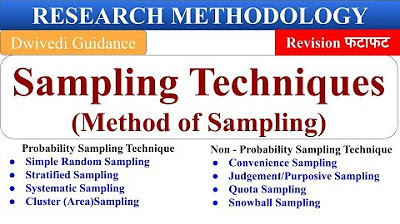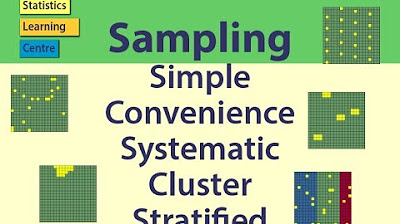Cluster Sampling
Summary
TLDRThis script explains the concept of cluster sampling in contrast to stratified sampling. The speaker illustrates that in cluster sampling, the population is divided into natural groups or 'clusters', such as people living on different streets. To conduct the survey, simple random sampling (SRS) is used to select a single cluster, in this case, Main Street. The researcher then interviews everyone within the chosen cluster, making the process more efficient and manageable.
Takeaways
- 😀 Cluster sampling is a sampling technique where the population is divided into groups or clusters.
- 🔍 Unlike stratified sampling, cluster sampling groups individuals based on natural divisions, such as geographical locations.
- 🏠 The example given is of people living on different streets, which are the natural clusters in this context.
- 📍 In cluster sampling, the researcher uses simple random sampling (SRS) to select a cluster from the population.
- 🎯 Once a cluster is chosen using SRS, the researcher interviews all individuals within that cluster.
- 👥 The selection of individuals for the sample is not random; it's based on the cluster that was randomly selected.
- 🔑 The process involves numbering the clusters (e.g., Maple Street as 1, Main Street as 2, 1st Street as 3) and then using SRS to pick a number.
- 🚶♂️ The purpose of cluster sampling is often to save time and resources, making the data collection process more efficient.
- 📝 It's important to note that every person in the chosen cluster is interviewed, not just a random selection of individuals.
- 🤔 The script emphasizes the difference between cluster sampling and stratified sampling, highlighting the method of grouping in each technique.
- 🔄 The script suggests that cluster sampling can be particularly useful when the population is spread over a large area.
Q & A
What is the main difference between cluster sampling and stratified sampling?
-The main difference is that in stratified sampling, the population is divided into subgroups based on certain characteristics, while in cluster sampling, the population is divided into natural groups or clusters, and one or more of these clusters are randomly selected for the study.
What is a cluster in the context of cluster sampling?
-A cluster in cluster sampling refers to a natural grouping of the population. For example, in the script, the clusters are groups of people living on different streets within the same neighborhood.
Why might someone choose cluster sampling over other sampling methods?
-Cluster sampling might be chosen when it is impractical to sample every individual in the population due to time or resource constraints. It allows for a more manageable and efficient sampling process.
How is simple random sampling (SRS) used in the context of cluster sampling?
-In cluster sampling, SRS is used to randomly select the clusters that will be included in the study. For instance, streets are numbered and one is randomly chosen for the interview.
What is the process of selecting a cluster using SRS as described in the script?
-The process involves numbering each cluster (e.g., streets), then using SRS to randomly select a number within the range of cluster numbers, which determines the cluster to be studied.
What is the assumption when interviewing people from the chosen cluster?
-The assumption is that every individual within the chosen cluster is willing to participate in the interview, providing a complete sample from that cluster.
Can cluster sampling be used when the population is homogeneous?
-Cluster sampling is typically used when the population is not homogeneous and there are natural groupings that can be identified and sampled.
How does the script illustrate the efficiency of cluster sampling?
-The script illustrates efficiency by showing how selecting a single street (cluster) can save time and effort compared to interviewing individuals spread across the entire neighborhood.
What are some potential drawbacks of cluster sampling?
-Potential drawbacks include the possibility of increased sampling error if the clusters are not representative of the entire population or if there is a high degree of variability within clusters.
How does the script differentiate between the numbering of individuals and the numbering of clusters?
-The script explains that in cluster sampling, instead of numbering individuals, the clusters themselves are numbered, and one or more of these numbered clusters are selected for the study.
Can you provide an example of a situation where cluster sampling might not be appropriate?
-Cluster sampling might not be appropriate in situations where the clusters are too similar to each other and do not represent the diversity of the entire population, or when the population is too small to form meaningful clusters.
Outlines

هذا القسم متوفر فقط للمشتركين. يرجى الترقية للوصول إلى هذه الميزة.
قم بالترقية الآنMindmap

هذا القسم متوفر فقط للمشتركين. يرجى الترقية للوصول إلى هذه الميزة.
قم بالترقية الآنKeywords

هذا القسم متوفر فقط للمشتركين. يرجى الترقية للوصول إلى هذه الميزة.
قم بالترقية الآنHighlights

هذا القسم متوفر فقط للمشتركين. يرجى الترقية للوصول إلى هذه الميزة.
قم بالترقية الآنTranscripts

هذا القسم متوفر فقط للمشتركين. يرجى الترقية للوصول إلى هذه الميزة.
قم بالترقية الآنتصفح المزيد من مقاطع الفيديو ذات الصلة

What Are The Types Of Sampling Techniques In Statistics - Random, Stratified, Cluster, Systematic

Probability vs non probability

Cluster Sampling: Definition, Examples

sampling techniques, types of sampling, probability & non probability sampling, Research methodology

Sampling Methods 101: Probability & Non-Probability Sampling Explained Simply

Sampling: Simple Random, Convenience, systematic, cluster, stratified - Statistics Help
5.0 / 5 (0 votes)
